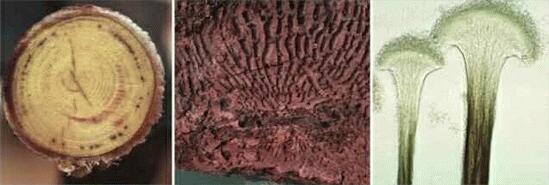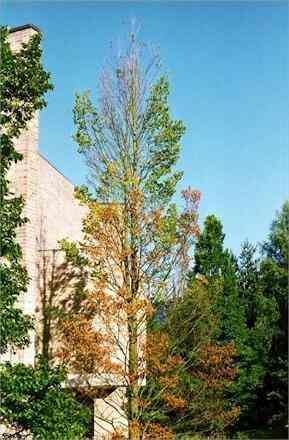Dutch elm disease Evidence from pollen analysis in peat sediments suggests that there were major fluctuations in elm populations in prehistoric times, related primarily to climate change but also perhaps to disease caused by the fungus Ophiostoma ulmi, the cause of Dutch elm disease. In more recent times, a
major pandemic spread across the Northern Hemisphere in
the 1920s to 1940s. It was seen first in the Netherlands
(hence the name, Dutch elm disease), then spread through
continental Europe and into the USA, ravaging the elm
populations. The disease then declined in Europe (though
not in the USA) but re-emerged in an even more virulent
form to affect Britain (in the mid-1960s) and most of
Europe. Strains of the fungus isolated from this more
recent outbreak show some cultural and molecular
differences from the older strains, and also fail to
interbreed with them, so they have been described as a
new species, Ophiostoma novo-ulmi.
Elm tree showing typical symptoms of infection by Ophiostoma novo-ulmi. The leaves on most of the branches have turned yellow or died, whereas other elm trees nearby (see extreme left or right of the image) are entirely healthy. From a photograph taken on the King's Buildings site of Edinburgh University in July 1999. This tree looked perfectly healthy, with no evidence of infection, in April 1999. |
||||
 The sequence above shows one tree in an avenue of mature elm trees in Cambridge, showing progressive development of Dutch elm disease from May (left) when the leaves of some branches first started to die, through July (centre) when many leaves were yellowed or dead, to September (right) when the tree was dead. Branches cut from such trees show characteristic discoloration of the xylem vessels as in the image on the left, below, although in this case the ring of discoloured vessels represents a previous year's infection that was too mild to kill the tree. The truncated appearance of elm trees in towns (see right-hand image above) is not related to disease but to the practice of lopping by municipal authorities. Rudyard Kipling's poem "In Praise of Oak and Ash and Thorn" begins:
|
||||
 |
||||
The disease cycle Elm bark beetles (mainly of the genus Scolytus) are the vectors of Dutch elm disease, and the cycle begins when young adult beetles emerge from the bark of dead trees in spring. They are often contaminated with fungal spores. They fly to the young shoots of healthy elm trees where they feed on the young bark, and also damage some of the underlying xylem vessels. The spores of O. ulmi gain entry in this way, and the fungus spreads rapidly in the xylem vessels by growing in a yeast-like budding phase. Either the whole tree or its major branches are killed. The newly killed bark is suitable for egg-laying, and in autumn, the female adult beetles burrow into the bark and lay their eggs in an elongated chamber - the brood gallery (centre image above). The beetle larvae hatch from these eggs and eat the bark, producing a series of radiating chambers that get wider as the larvae grow. At this stage they pupate, ready to emerge as young adults the following spring. Meanwhile, the fungus that killed the tree grows from the xylem into the bark and produces its characteristic sporing structures in the brood galleries. The commonest type of structure is termed a synnema (right-hand image), consisting of an aggregation of hyphae (conidiophores) that fan out to produce minute spores in a sticky droplet at the tip. Only the basal part of this droplet is seen in the picture. These spores contaminate the beetles when they emerge in spring to repeat the disease cycle. Pathogen population structure A range of molecular tools have been used to analyse the population structure of O. novo-ulmi in the current European pandemic. Based on comparisons of random DNA fragments (produced by cutting the DNA with restriction enzymes) and the abilities of strains to fuse with one another in culture (indicating cytoplasmic compatibility), the population at the advancing front of the pandemic in Europe seems to be genetically uniform. This we could expect in conditions where an abundance of healthy host trees creates selection pressure for the most virulent component of the fungal population. But behind the fronts, the population shows much higher diversity - a result of stabilising selection where factors other than virulence are favoured. |
||||
| Further reading: AG Mitchell and CM Brasier, 1994. Contrasting structure of European and North American populations of Ophiostoma ulmi. Mycological Research 88, 576-582. Webpage:
|
||||

